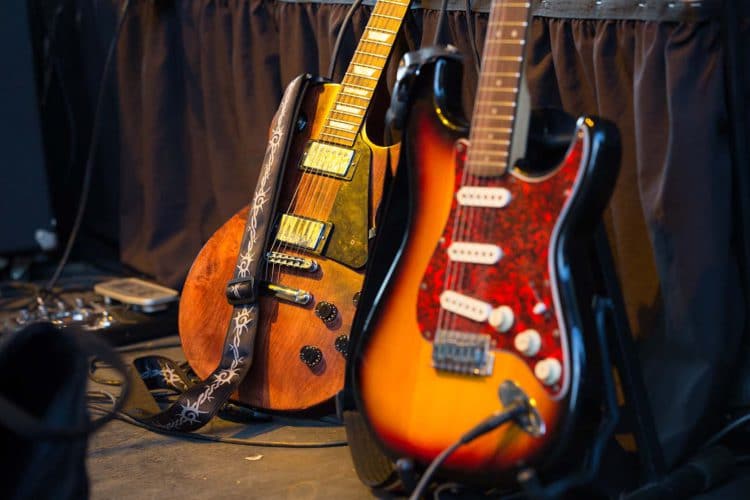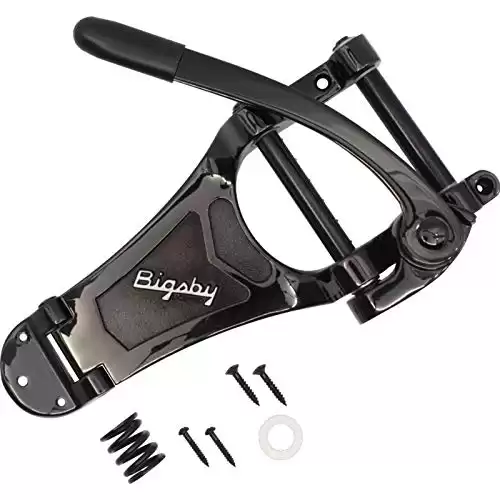Paul Bigsby once declared that he could build anything. When we made that statement, he went from building Crocker motorcycles to creating musical instruments.
Bigsby was a foreman in the LA machine shop where Crocker motorcycles were built. He would eventually form a relationship with Merle Travis, who needed help with his Gibson L-10. It had a worn Kaufman that wouldn’t stay in tune.
Instead of repairing the mechanism, Bigsby built something new from scratch. It would be the decision that changed his life. He would create steel guitars, custom instruments, and vibratos.
In 1966, Ted McCarty purchased the name and inventory. In 1999, Gretsch bought them from the former head of Gibson Guitars.
Adding a Bigsby on a Strat
The Bigsby vibrato unit installs on the top of the Strat. It works with the bridge in its spring-loaded design to attached to a pivoting metal bar around which the strings get installed. When left in the neutral position, the pitch and tone remain the same. Musicians that engage the arm can raise or lower the pitch.
Although Bigsby vibratos come factory installed on several models, ranging from Epiphone to Gretsch, one of the best options is to retrofit this tech to a Strat. That’s because it requires zero routing of the body.
You can find different options of the Bigsby to work with the various guitar styles out there today, such as the solid or hollow body.
Each unit ships with its own rocker bridge, although you can update it for a Jazzmaster or a Tune-o-Matic, if that is your preference.
What You Need to Know to Create Killer Vibrato
A Bigsby makes sense on a Strat because it simplifies the process of creating vibrato. When it gets mixed with legato, bending, and harmonics, any musician can become a dynamic player with some practice.
If you’re interested in adding vibrato to your Strat, here are the things you’ll need to know to have a successful experience with your Bigsby.
1. Bends and Vibrato Are Different Elements.
Guitarists used the bend technique to move sound from one note to another. If you were to play a C on a Strat, this technique would bend it up a full step to a D.
Although it modulates the pitch, it’s not the same rapid audio movement that occurs when routing it through a Bigsby.
You also go toward the flat and sharp instead of only getting one-way directional movement.
2. Vibrato and Tremolo Are Also Different.
Some musicians use the terms “tremolo” and “vibrato” interchangeably, but they are separate effects you can play with a Strat.
Vibrato is the periodic pitch variation in the frequency of a specific note. When you use tremolo, you’re changing the amplitude (volume) of it.
Many beginners mistake vibrato for tremolo. When you install a Bigsby, it’s much easier to vibrate the string to create the tone variations through movement instead of volume.
3. You Can Create Vibrato without a Bigsby.
The reason why a Bigsby is a reasonable investment is that it adds vibrato to your playing without the extra physical effort. You must move your hand in different ways to create the specific effects when producing it manually, including circular, vertical, or horizontal.
Some players try to create vibrato with their fingers, but that technique is closer to a bend. You need to make it come from the wrist to have the most success as the wobble becomes more pronounced with the extra movement.
A few guitarists like to create manual vibrato by anchoring their thumb to the instrument’s neck. B.B. King is famous for using only the finger holding the string to be in contact with it.
4. Vibrato Is Possible with One or More Fingers.
You still need your fingers to create vibrato, even if the movement comes from the wrist. A subtle wobble is possible with a single placement, especially as you become more familiar with the fretting process.
If you want to sustain the vibrato for more than a few seconds, it might be necessary to use multiple fingers. The eventual goal should be to execute this playing style with all four fingers on the neck.
5. True Vibrato Comes after the Note Plays.
The one trap players get into when using a Bigsby is that they play the vibrato too early. It helps to think of an opera singer as you use this effect.
The vocalist will offer a powerful initial note, then vary the sound between the flat and sharp (or more) to create a noticeable audio wobble.
This process is the same on the guitar. Let the note ring for a moment before beginning the vibrato wobble. Listeners want to hear the actual pitch first before the variations occur.
6. Understand Where Vibrato Goes in the Music.
When using a Bigsby, it is essential to remember that you can have too much of a good thing. This effect shouldn’t be added to every note. The best place for it is when a long sustain is necessary.
Instead of treating listeners to a monotonous note, the vibrato adds something interesting. When it’s there constantly, the benefits get watered down to the point where it gets ignored.
7. Think about Speed, Type, and Notation.
When you add vibrato to any music, you’ll want to think about its dynamics from a listening point of view.
Three primary ingredients create the right wobble for each composition, and it is up to you to determine which ones make the most sense in your situation.
| Speed: | • You can play vibrato fast or slow with a Bigsby. • That means the note can come across as being aggressive or somewhat sleepy. • If you’re playing the blues, a slower motion can add circular qualities to a riff. • When you’re jamming out to some heavy rock, something faster creates a quicker, narrower experience. |
| Type: | • Musicians incorporate traditional, classical, or blues vibrato into their music. • The first option causes you to move the wrist vertically to bend the string upward while letting it rest back. • You’ll feel it in your elbow the first few times. • Classical vibrato uses a left-to-right motion with the hand while the finger keeps full pressure on the string. • This effect creates a tighter and looser playing experience to develop the wobble. • Blues vibrato is more exaggerated and requires less symmetry. • It needs to have your thumb on the fretboard to get enough height on the string movement. |
| Notation: | • When you see a “V” or a squiggly line in your sheet music, that indicates a vibrato is expected in that place. • What you won’t see are instructions for speed and release. • That’s why playing it with a Strat and a Bigsby can be lots of fun. • You get that vintage tone, some extra help with the variation, and a signature sound. |
8. You Can Simulate Vibrato with Your Whammy Bar.
Jeff Beck does some incredible stuff with his whammy bar. Instead of using regular vibrato, he takes on a wider range with this tool for raising or lowering the overall pitch.
You’ll find that a little goes a long way with this technique, especially when creating slides and bends.
A Final Thought on Adding a Bigsby to a Strat
It takes time to create a signature sound with your vibrato. Don’t rush the process! When you move slowly and steadily toward what you like to hear, you can gradually increase the tempo. Although it might be tempting to copy what you hear from others, try to develop your own nuances.
My first encounter with vibrato happened while learning how to play the baritone. My instructor had our band play a piece that involved a solo for me. I never thought anything about note variation.
Honestly, my primary thought back then was to make sure my fingers hit the valves correctly. Vibrato? Did that matter?
After a few weeks of practicing, I got to the point where I could move the base note through the brass instrument up or down a half step with facial inflections. By the day of the concert, I was ready for a sterling performance.
Although the guitar is a very different instrument, I’ve found that the vibrato principles I learned so long ago (and shared above) still apply. It’s fun to manually initiate this effect, but the Bigsby B-700 makes life a lot easier.
This Bigsby comes from the Lightning Series II collection. It is made of die-cast aluminum, ensuring that only 345g of extra weight gets added to the guitar.
In return, you’ll have tons of control over note shaping so that= every song feels like something new.
It takes a little time to get to know a Bigsby. I highly recommend visiting a local luthier to complete the installation on a Strat!
Once you’ve got the setup complete, you’ll find that playing the guitar has never been as much fun.


